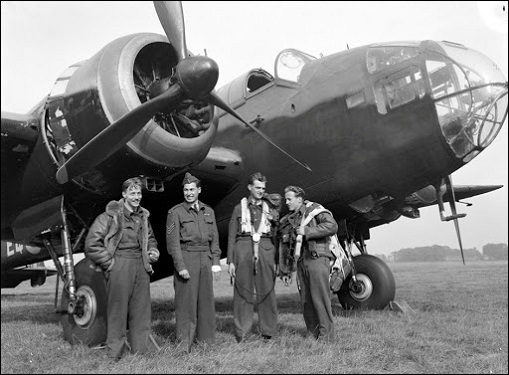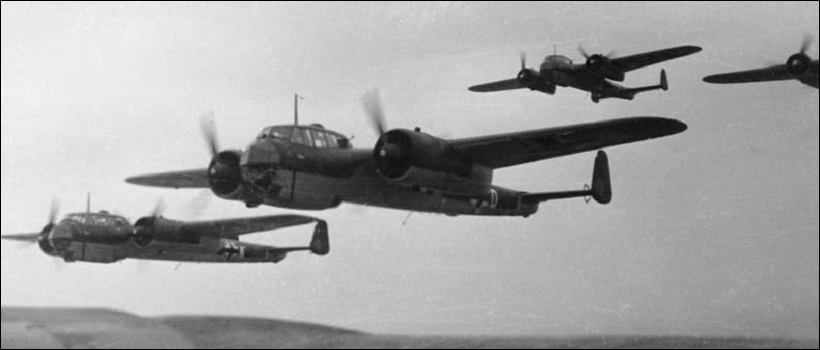● ● ●
Contrary
to official and popular expectations in Britain and France,
the war that came in September 1939 did not open with the
dreaded aerial knockout blow. The
Luftwaffe was busy
in Poland, supporting the invading German armies by bombing
and strafing Polish troops, supply columns and airfields. To
be sure, Polish cities were bombed as well, but such attacks
were more in the nature of a terror campaign than a
sustained strategic air offensive. In actual fact, the
Luftwaffe was not
organized or trained for strategic attack. It was primarily
a tactical air arm, and in that role it proved most
effective.
The
situation in Britain was quite different. The Royal Air
Force expansion scheme of the later 1930s had produced three
long-range twin-engine medium bombers: the Armstrong
Whitworth Whitley, the Handley Page Hampden and the Vickers
Wellington. These entered service from 1937 onward and were
a considerable improvement over earlier types like the
Boulton Paul Overstrand, the RAF’s last
biplane twin-engine bomber. The Wellington especially, with
its innovative geodetic airframe, power-operated nose and
tail turrets and 4,500lb bomb load, seemed impressive. The
RAF believed that its new bombers, flying in close
formation, protected by the interlocking fields of fire of
their defensive machine guns, could fight their way through
enemy airspace in daylight to make precision attacks on
critical industrial targets.
At the beginning of the war Bomber
Command had three groups equipped with these medium bombers:
No. 2 with eight squadrons of Wellingtons, No. 4 with six
squadrons of Whitleys and No. 5 with eight squadrons of
Hampdens: some 260 operational aircraft in total, plus
another 60-70 or so in No. 6 Group (Training). This was none
too large a force but sufficient, the RAF’s leaders judged,
to commence attacks on strategic targets.

Handley Page Hampden Mk I
bomber and crew: pilot, navigator/bomb aimer, wireless
operator/gunner, gunner (Imperial War Museum)
But in
its desire to strike at Germany, the RAF was initially
frustrated. The British and French governments, fearing
retaliation, rejected the idea of launching an immediate
strategic air offensive; raids on German cities and industry
were therefore ruled out. Operations over Germany were
limited to propaganda leaflet raids—ignominious “confetti
warfare” in the words of one disgruntled member of
Parliament. RAF Bomber Command’s first real attacks were
directed against German warships and naval bases—with the
proviso that civilian casualties were to be avoided. The
results were disappointing, however. Though several German
warships were sunk or damaged between September and December
1939, RAF losses were unexpectedly heavy.
A most
unfortunate climax came on 18 December 1939, when
twenty-four Wellington medium bombers were dispatched to
attack German warships in the Heligoland
Bight. Two of the Wellingtons developed engine trouble and
turned back; the rest pressed on to the target area. Flying
through a heavy but inaccurate antiaircraft barrage they
bombed a number of ships without either inflicting or
suffering any serious damage. But as they turned for home
the Wellingtons were intercepted by a force of German
fighters: single-engine Bf 109s and twin-engine Bf 110s. In
the subsequent running battle, twelve Wellingtons were shot
down, the Germans losing only three Bf 109s. It was obvious
that such a rate of loss was unsupportable and the Battle of
Heligoland Bight, as it came to be called, convinced the RAF
to abandon daylight attacks in favor of night bombing.
The seven-month lull that followed the
defeat of Poland—dubbed the Phony War by journalists—came to
an end in May 1940 with the German invasion of France and
the Low Countries. Once again the German Army, with the
Luftwaffe in close
support, scored a quick victory. During the campaign there
was a further example of terror bombing: the German attack
on Rotterdam (14 May 1940), which destroyed the city center,
killed nearly 900 people and convinced the Dutch military
command to capitulate. The subsequent defeat of the French
Army and the evacuation of the British Expeditionary
Force—minus all its heavy equipment—from Dunkirk set the
stage for the first major air battle of the Second World
War.
The Battle of Britain provided a clear
demonstration of the gap between strategic bombing theory
and operational realities. Initially, the primary mission of
the Luftwaffe was to
suppress British air defenses. This was the essential
preliminary to the invasion of Britain that Hitler, after
unsuccessful attempts to reach a negotiated settlement, had
ordered. Only if the Germans could dominate the airspace
over the English Channel and southeast England would
Unternehmen Seelöwe
(Operation
Sea Lion), as the invasion was christened, be feasible. Thus
the Luftwaffe’s
priority targets were RAF Fighter Command’s airfields,
command and control infrastructure and radar stations.

The bomber's nemesis:
Supermarine Spitfire Mk I fighters of No. 610 Squadron, RAF
Fighter Command, in 1940 (Imperial War Museum
But though the British defense was pushed
to the limit of its endurance it did not collapse. For the
RAF it was a costly victory—nearly 1,000 aircraft and over
1,400 aircrew lost. The Luftwaffe too suffered
heavily—losing upwards of 1,800 aircraft and 2,600 aircrew.
Another casualty was the planned invasion of Britain. By the
autumn of 1940 it was clear that the Luftwaffe had failed to
achieve air superiority over the projected invasion area.
Accordingly, Seelöwe
was first postponed and finally cancelled.
There followed
the Blitz: a sustained bombing campaign targeting British
cities that ran from November 1940 to the spring of 1941,
when many Luftwaffe units were withdrawn from France to
support the imminent invasion of the USSR. Bitter experience
having revealed that its bombers, unescorted, were sitting
ducks for Fighter Command’s Hurricanes and Spitfires, the
Luftwaffe switched to night bombing. But though the Blitz
inflicted a great deal of damage and killed many British
civilians, it too ended in failure. And in retrospect, the
reason it failed is obvious: The German bombers lacked the
range and load-carrying ability to conduct a true strategic
air campaign.
The
Luftwaffe’s
three medium twin-engine bombers—the Heinkel He 111, the
Dornier Do 17 and the Junkers Ju 88—had proved most
effective as tactical bombers, attacking troop
concentrations, rail targets and airfields in support of the
ground forces. But they were ill suited for the strategic
role. As the RAF had already discovered, bombers attacking
in daylight could not rely on their own defensive armament
against defending fighters. During the Battle of Britain,
therefore, the radius of action of the German bombers was
determined by the maximum practical range of their fighter
escorts. And though the cover of darkness rendered them far
less vulnerable, their relatively small bomb loads limited
their effectiveness. The Do 17, for instance, could carry
only 2,000lb of bombs, none larger than 500lb.

Do 17Z bombers of the
Luftwaffe during the Battle of Britain (Bundesarchiv)
The Blitz was the last serious German
attempt to conduct a strategic air offensive. The Luftwaffe,
increasingly hard pressed as the war went on, had no
opportunity to develop and field the type of heavy bomber
with which the British and American air forces were
ultimately equipped. The He 111, a bomber that entered
service in 1935, was still serving—and still in
production—in 1944. Thus with the end of the Blitz, the
initiative passed to the Allies and henceforth, strategic
bombing theory would be put to the test against urban
Germany.
● ● ●